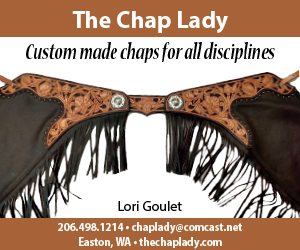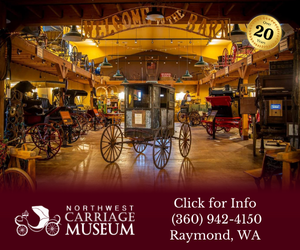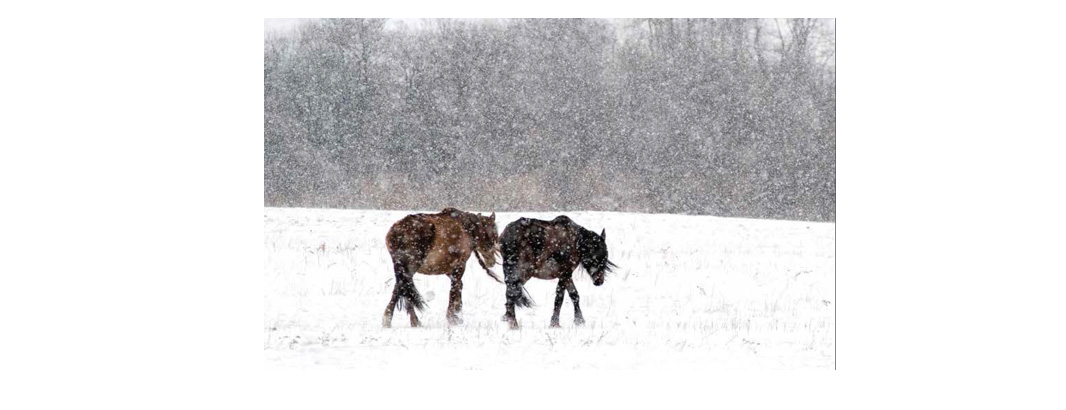Get a Leg Up When You’re Alone
by Theresa Rice

I’m always on the lookout for new horse products to try. Recently, I came across the Solo-Ride mounting aid and was intrigued. After I read about the product’s origin I became smitten with the story.
Isn’t the dream to hop on your horse bareback and head out into the eternally sunny fields behind your barn for miles on end? Regardless of your discipline, a bareback ride is good for the soul. A bareback ride out the back gate is even better. But what happens if you have to get off your horse miles into that dreamy ride and can’t find a boost back onto your horse? That’s exactly what happened to Randell on a solo bareback ride that inspired her to create the Solo-Ride mounting aid.
A Solo-Ride mounting aid was provided free of charge to review for this article. The Solo-Ride is an open-sided stirrup on a nylon strap that is designed to loop around the foreleg of your horse on the opposite side from which you are mounting.
The strap loops around the leg and shoulder, drapes over just in front of the withers, and rests at about the height of a regular saddle stirrup. The strap comes with a padded section to protect your horse from the hardware. After you’ve settled onto your horse’s back, you unclip the strap at the metal ring and slide it off your horse. Then you can tuck the strap and buckle into a small wearable pack for the duration of the ride.
If you use the mounting stirrup to get on a horse that is already saddled, I would suggest tucking the Solo-Ride into a saddle bag or attaching the included bag to your saddle with pack strings as it’s possible the strap from the carrying pouch could get hooked over your saddle horn and end up causing a wreck.
The Solo-Ride is a genius invention to help you get back on your horse if you’re without a boost or a high enough log. If I were to use this item long-term I would make a fleece sleeve to slip over the nylon strap, as I think it has the potential to rub or pinch my horse’s skin if used frequently. I had a rider who is under 120 pounds try the Solo-Ride with an almost 17-hand stock horse as well as a 15-hand Arabian cross. Both horses tolerated the mounting aid but did shift their weight during mounting in order to offset the pulling from the strap.
I am over 170 pounds and tried the Solo-Ride on the 15-hand Arabian cross. The way he flexed his back during my trial of the mounting aid made me feel that it wasn’t a good fit for my weight and his lighter frame. Another rider about 120 pounds tried the Solo-Ride on a 14.2 draft cross that hardly even noticed.
Rider fitness, rider weight, and horse build are all considerations in deciding whether the Solo-Ride is right for you and your equine. If you are thinking about purchasing one but are unsure, Solo-Ride allows a full refund if returned in the first 30 days.
Once you receive your Solo-Ride, make sure to practice with it in the safety of a round pen before you need it out on the trail. You want to make sure your horse will tolerate this device. It’s a different sensation from the other ways we typically mount or ride or horses. Also, the first time I tried the Solo-Ride I was grasping for a cantle that wasn’t there (I was mounting bareback). I’m not sure if I grab the cantle normally during mounting, but that’s what I found myself doing, so that’s another reason why I suggest practicing with the Solo-Ride before you truly need to use it.
For the horse person who has everything, the Solo-Ride can be the gift they never knew they wanted.
Available at hairybackranch.com
Originally Published December 2017 Issue

Theresa grew up riding horses off and on throughout her life, finally fulfilling her dream of horse ownership in 2012. She is currently working on her first novel, inspired by her time spent working on a guest ranch in Arizona where she met her husband. They married in 2012. When not writing, you can find her riding her half-Arabian gelding, Gangster, or chasing after her two German Shepherds. website: www.sassinboots.com









It might be “dreamy” to ride bareback…you can see all those pictures of women riding the bareback stallion in meadows or along the ocean shore….But does anyone who rides bareback ever consider what they might be doing to the horse’s back. Horse were never “built” to carry a person, hence we have saddles with trees. The tree distributes the weight of the rider across the back, and never directly on the backbone, regardless if he or she is a 5’4″, 95 lb person, or someone somewhat heavier….. The problem bareback riding is all of the rider’s weight is directed down at a point on the backbone, which in time can injure or even lame a horse.
This is supported by veterinarian peer-reviewed studies….
Hopefully, the next time you decide to ride bareback, you take a look at your horse and ask, “Should I really do this to you?!”
Rick